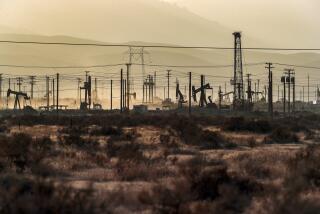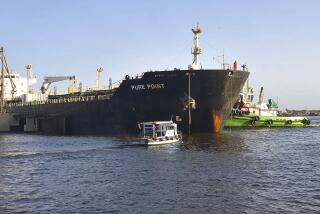Action Would Lower Prices, Raise Risks
- Share via
Releasing crude oil from the nation’s vast strategic reserve would probably lower the price of oil somewhat and help to rebuild perilously low inventories of heating oil and gasoline, energy analysts said Thursday.
But like raiding the family nest egg, tapping the Strategic Petroleum Reserve, which was created by Congress in the 1970s to protect against threats to national security, carries risks that make its use as a price-dampening measure highly controversial.
Critics warn that depleting the reserves would leave the United States vulnerable to oil-supply disruptions should the Organization of Petroleum Exporting Countries retaliate by pumping less oil, war erupt again in the Middle East, Iraq decide to use its oil exports for political gain or an errant hurricane damage key U.S. production facilities.
The strategic reserve, now totaling 570 million barrels of crude, is stored in huge underground salt caverns near the Gulf of Mexico.
As oil prices have remained stubbornly high in recent months, members of Congress have urged President Clinton to order loans of oil from the emergency stockpile to energy companies, which then would sell the oil on the open market in the expectation that the increase in supply would bring prices down. The oil companies would replace the oil later, when prices drop, with more barrels than they borrowed.
Political pressure to open the reserves pumped higher Thursday when Vice President Al Gore in a campaign speech proposed a series of test swaps from the reserve of perhaps 5 million barrels at a time. The Energy Department last week suggested a release of up to 60 million barrels.
Talk of releasing oil from the Strategic Petroleum Reserve brought an immediate negative reaction from the oil industry, which also doesn’t much like Gore’s repeated characterization of its companies as profiteers.
“While tight worldwide crude oil supplies have caused the cost of all petroleum products to increase, our companies are doing everything they can to supply consumers with home heating oil, natural gas and other fuels they will need in the coming winter,” the American Petroleum Institute said in a statement. The strategic reserve “was not intended, and should never be used, to manipulate prices.”
The reserve was set up by Congress in 1975, two years after the Arab oil embargo led to long lines at gasoline stations, doubled gas prices and firmed U.S. resolve to reduce reliance on foreign oil. The stockpile was tapped only once before for emergency purposes, during the 1991 Gulf War, when oil hit record prices. But small swaps have been conducted since, including this summer to ease the gasoline supply shortage in the Midwest.
Those shortages were due to regional distribution problems. The current supply problem is international in scope, with inventories of crude oil and petroleum products near record lows in the United States so that any disruption in supply pushes prices higher.
A release of oil from the Strategic Petroleum Reserve would surely stabilize world prices in the short term, because it will increase supplies and “send a very strong message to the market and to OPEC that the United States means business and is willing to do whatever it takes to bring prices down,” said Fadel Gheit, senior energy analyst at Fahnestock & Co.
More stable prices, in turn, would give oil companies the confidence to rebuild stockpiles, something they are reluctant to do when prices swing wildly.
But any price reduction could be offset if OPEC cuts its own production in response, as cartel officials threatened at the group’s latest meeting. That Sept. 12 gathering brought agreement from the OPEC ministers to increase production by 800,000 barrels a day on Oct. 1.
What’s more, U.S. refineries are already operating at full capacity to produce heating oil for this winter so that any extra supplies of petroleum would be of little use, said David Pursell, a research vice president at Simmons & Co., Houston-based investment bankers.
“Adding more oil is not going to create more heating oil,” Pursell said. “Refiners are operating at capacity.”
Tapping the reserve dilutes its value as the nation’s cushion against actual petroleum shortages, whether from political disruptions in the Mideast or weather, said Allen Mesch, director of the Maguire Energy Institute at Southern Methodist University in Dallas.
“The use of the Strategic Petroleum Reserve to affect oil prices is the government messing about with the free market, or quasi-free market,” Mesch said. “I think that’s a dangerous thing.”
But others say that overstates the danger. Analyst George Beranek of Petroleum Finance Co., a Washington-based consulting firm, said the reserve is big enough to handle the proposed sales and still take on a serious disruption--for example, Iraq withholding its 2.5 million barrels a day in exports.
He predicted that such a worldwide crisis would push the International Energy Agency, a Paris-based oil watchdog, to get other industrialized nations to release some of their reserves as well, estimated at another 630 million barrels.
(BEGIN TEXT OF INFOBOX / INFOGRAPHIC)
Tapping Into Reserves
Vice President Al Gore’s proposal to tap into the nation’s Strategic Petroleum Reserve would siphon oil in 5-million-barrel parcels from the 570 million barrels stored in underground salt caverns along the Gulf of Mexico coast. This has been done only once before on a large scale--during the 1991 Persian Gulf War.
How Oil Is Stored
Each of the reserve’s four sites stores emergency crude oil in underground chambers leached out of salt dome formations. With the capacity to hold 700 million barrels, the reserve is the world’s largest emergency stockpile.
Creating a Cavern
1. Well is drilled into salt dome.
Fresh water is pumped into formation to dissolve salt, creating brine.
2. Cavern grows as more water is injected. It takes about seven barrels of water to create space to hold one barrel of crude oil.
3. Oil is pumped into cavern at top, which causes displacement of brine at bottom. Brine flows through pipes to surface, where it is pumped into deep wells or into the Gulf of Mexico.
4. Oil is withdrawn by pumping fresh water into bottom of cavern, which causes displacement of oil to surface.
Source: U.S. Department of Energy
Researched by JULIE SHEER / Los Angeles Times
More to Read
Sign up for Essential California
The most important California stories and recommendations in your inbox every morning.
You may occasionally receive promotional content from the Los Angeles Times.













